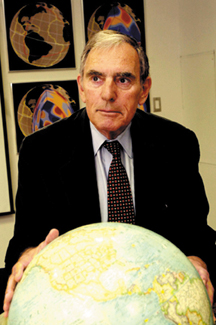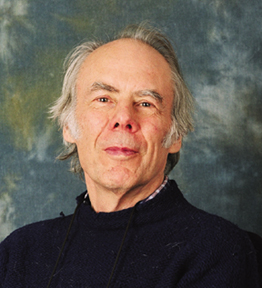Geotimes

Society
Page:
News about people from AGI and its 40 member societies
Christina
Reed
To post news in Society Page, send e-mail to car@agiweb.org
with the subject: Society Page.
William Bowie medalist
Awards of excellence
Archive of past Society Page stories by date
William
Bowie medalist
 “Earth
rings like a bell after an earthquake,” says Adam Dziewonski of Harvard
University. “All we have to do is pick up the tones.” Dziewonski did
just that about 30 years ago when he and colleagues pioneered the use of shock
waves from earthquakes to obtain computerized 3-D views of Earth's interior.
The technique allowed Dziewonski and collaborating deep-earth researchers to
conclude that Earth's inner core is solid and rotates faster than the surface.
Today the Frank B. Baird Jr. Professor of Science at Harvard continues to investigate
the deepest mysteries of our planet.
“Earth
rings like a bell after an earthquake,” says Adam Dziewonski of Harvard
University. “All we have to do is pick up the tones.” Dziewonski did
just that about 30 years ago when he and colleagues pioneered the use of shock
waves from earthquakes to obtain computerized 3-D views of Earth's interior.
The technique allowed Dziewonski and collaborating deep-earth researchers to
conclude that Earth's inner core is solid and rotates faster than the surface.
Today the Frank B. Baird Jr. Professor of Science at Harvard continues to investigate
the deepest mysteries of our planet.
Last month, the American Geophysical Union (AGU) awarded the 2002 William Bowie
Medal to Dziewonski at its fall meeting in San Francisco. He was recognized
for “his fundamental contributions to the understanding of the structure
and dynamics of the Earth and the character and distribution of seismic energy
release, for dramatically improving our understanding of how seismic waves propagate,
and for his willingness to share his expertise with his colleagues to further
this research,” according to an AGU press release.
2002 William Bowie medalist
Adam Dziewonski of Harvard University. Courtesy of A. Dziewonski.
The award presentation came a month after Miaki Ishii, also of
Harvard, and Dziewonski reported in the Proceedings of the National Academies
of Sciences that they found that the innermost part of Earth's inner core
is not homogeneous. “The inner core itself is so small that it is difficult
to say much about it,” says Don Anderson of the California Institute of
Technology. “It is a small target for seismologists.”
The fact the Dziewonski and Ishii are able to unravel details of the innermost
300 kilometers of the Earth is a remarkable feat. The inner core appears not
to be uniform but has an anisotropy that varies with depth. There are various
ways to add material to the inner core and this new result suggests that it
had a complex history.” Both Anderson and Dziewonski won the Swedish Academy
of Sciences' Crafoord Prize in 1998 for their pioneering work on mapping the
interior of Earth.
Back to the top
Awards
of excellence
AGU also gave honors to eight other scientists during its fall meeting in San
Francisco in December.
Stuart Ross Taylor, a professor emeritus and visiting fellow of the Australian
National University in Canberra, received the Walter Bucher Medal for his fundamental
contributions to the understanding of the chemical composition, origin and geochemical
evolution of the continental crust.
 Sir Nicholas J.
Shackleton of the Goodwin Institute for Quaternary Research at the University
of Cambridge, received the Maurice Ewing Medal for his significant contributions
to paleoclimatology, stratigraphy and paleoceanography.
Sir Nicholas J.
Shackleton of the Goodwin Institute for Quaternary Research at the University
of Cambridge, received the Maurice Ewing Medal for his significant contributions
to paleoclimatology, stratigraphy and paleoceanography.
Ronald T. Merrill of the University of California at Berkeley received the John
Adam Fleming Medal for his original contributions to the understanding of rock
magnetism and dynamo theories of the origin of the geomagnetic field.
Gerald Schubert of the University of California at Los Angeles received the
Harry H. Hess Medal for his leadership role in and contributions to the understanding
of the dynamics and evolution of terrestrial planets.
Maurice Ewing medalist Sir Nicholas J.
Shackleton of the Goodwin Institute for Quaternary Research at the University
of Cambridge. Photo courtesy of AGU.
John M. Eiler of the California Institute of Technology in Pasadena and Michael
Manga of the University of California at Berkeley each received the James B.
Macelwane Medal, given for significant contributions to the geophysical sciences
by an outstanding scientist less than 36 years of age. AGU also presented this
award in May 2002 to Gabriel George Katul of Duke University.
Ralph J. Cicerone of the University of California at Irvine received the Roger
Revelle Medal for his extraordinary breadth of contributions to the understanding
of biogeochemical cycles and their effect on climate.
Daniel F. Weill, former program director of the National Science Foundation
Division of Earth Sciences, received the Edward A. Flinn III Award for his unselfish
efforts on behalf of the wider earth science community to meet the needs of
evolving instrumentation and facilities.
Also this year, AGU presented posthumously to Charles S. Falkenberg the award
established in his name. Falkenberg, research director of ECOlogic Corp., died
September 11, 2001, with his family onboard American Airlines flight 77, which
crashed into the Pentagon.
Back to the top
 “Earth
rings like a bell after an earthquake,” says Adam Dziewonski of Harvard
University. “All we have to do is pick up the tones.” Dziewonski did
just that about 30 years ago when he and colleagues pioneered the use of shock
waves from earthquakes to obtain computerized 3-D views of Earth's interior.
The technique allowed Dziewonski and collaborating deep-earth researchers to
conclude that Earth's inner core is solid and rotates faster than the surface.
Today the Frank B. Baird Jr. Professor of Science at Harvard continues to investigate
the deepest mysteries of our planet.
“Earth
rings like a bell after an earthquake,” says Adam Dziewonski of Harvard
University. “All we have to do is pick up the tones.” Dziewonski did
just that about 30 years ago when he and colleagues pioneered the use of shock
waves from earthquakes to obtain computerized 3-D views of Earth's interior.
The technique allowed Dziewonski and collaborating deep-earth researchers to
conclude that Earth's inner core is solid and rotates faster than the surface.
Today the Frank B. Baird Jr. Professor of Science at Harvard continues to investigate
the deepest mysteries of our planet. 
 Sir Nicholas J.
Shackleton of the Goodwin Institute for Quaternary Research at the University
of Cambridge, received the Maurice Ewing Medal for his significant contributions
to paleoclimatology, stratigraphy and paleoceanography.
Sir Nicholas J.
Shackleton of the Goodwin Institute for Quaternary Research at the University
of Cambridge, received the Maurice Ewing Medal for his significant contributions
to paleoclimatology, stratigraphy and paleoceanography. 